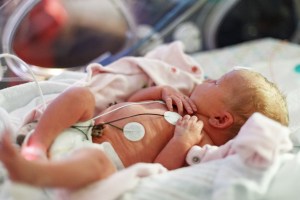Human milk is a critical resource for infants designed to meet the needs of baby at every stage of development. Human milk is alive with immune cells, stem cells, and microbes that come from both the lactating parent and from the baby (Hassiotou et al., 2013; Funkhouser and Bordenstein, 2013). For example, a thick yellow milk produced a few days after birth called colostrum (American Pregnancy, n.d.) can be thought of as baby’s first immunization (Khan, 2012).
Some of the unique findings in human breast milk include:
- Complex sugars called human milk oligosaccharides. While not actually digestible by human infants, they form the third most abundant solid component of human milk after lactose and fat. In addition, they function as a prebiotic, meaning they help establish good gut bacteria in the infant. They also protect against pathogens and other bad bacteria (Bode, 2006; 2012; Musilova et al., 2014; Tao et al., 2011; Nakano et al, 2001).
- Pluripotent stem cells. These cells have the ability to form any of the more than 200 different types of cells found in adult human bodies. These cells are active in the lactating parent and may behave similarly to immunofactors in the infant to play a role in tissue repair and development (Hassiotou et al., 2012).
In addition to the unique components of human breast milk, breastmilk has also been associated with improved myelination and increased general, verbal, and non-verbal cognitive abilities compared to children who were exclusively formula-fed at three months. These differences were found to persist into childhood even with groups matched for socioeconomic and demographic factors (Deoni et al., 2017).
A parent’s milk is unequivocally the best nutrition for a newborn infant. However, when a parent’s breast milk is unavailable to an infant for any reason, breast milk from a trusted donor source can be substituted to provide nutrition to the child in a quality second only to the biological parent’s own breast milk.
NICU babies are in particular need of the benefits of human milk.
This substitute breast milk can be especially important when a baby is born premature, since many times the parent of a premature infant is physically unable to produce the amount of milk needed by the child (La Leche League USA) or the infant has not developed sucking and swallowing mechanisms sufficient for nursing. The nutrients in human milk are especially critical for medically fragile premature infants. As a result, pasteurized donor human milk from a certified milk bank can be a critical resource for many newborns and their families so as to ensure a healthy and thriving baby.
In addition to premature births, there are a variety of other situations in which a newborn infant may not have access to their mother’s breast milk. Examples of these situations include when a baby is born via a surrogate, when the child is adopted or fostered, when the child is of same-sex non-nursing parents or when parents cannot nurse or choose not to.
The use of donor milk (or “milk sharing”) is not a new practice for humans. “Allomaternal care” and shared nursing has long been a part of many, if not most, human cultures yet there are no federal laws regulating the use of donor human milk or milk sharing. Milk banks provide a degree of quality control by screening donors based on lifestyle, teaching donors about best practices for expression, storage/transport of breastmilk as well as pasteurizing the donated milk. In comparison, informal milk sharing carries some risks given that there are no quality control regulations for the milk and no recourse available if the milk harms the child (La Leche League USA).
The 29-member milk banks that are part of the Human Milk Banking Association of North America (HMBANA) are governed by that organization’s protocols and regulations (HMBANA). Some U.S. states have enacted laws regulating milk banks, while few laws regulate informal milk sharing. Outside of the U.S. other countries have varying degrees of regulation for milk sharing and milk banks (La Leche League USA). Stay tuned for the next post, as we are excited to highlight the new San Diego Mother’s Milk Bank (download their app here).
About the author: India Olchefske, MPH, has a Master’s in Public Health from George Washington University and a Bachelor’s from the University of Chicago. Her graduate thesis focused on how the opioid epidemic affects rural pregnant women. She has worked at a variety of direct service, research and policy organizations with a focus on women’s and maternal health. She is currently pursuing a career as a ballet dancer in addition to public health.
